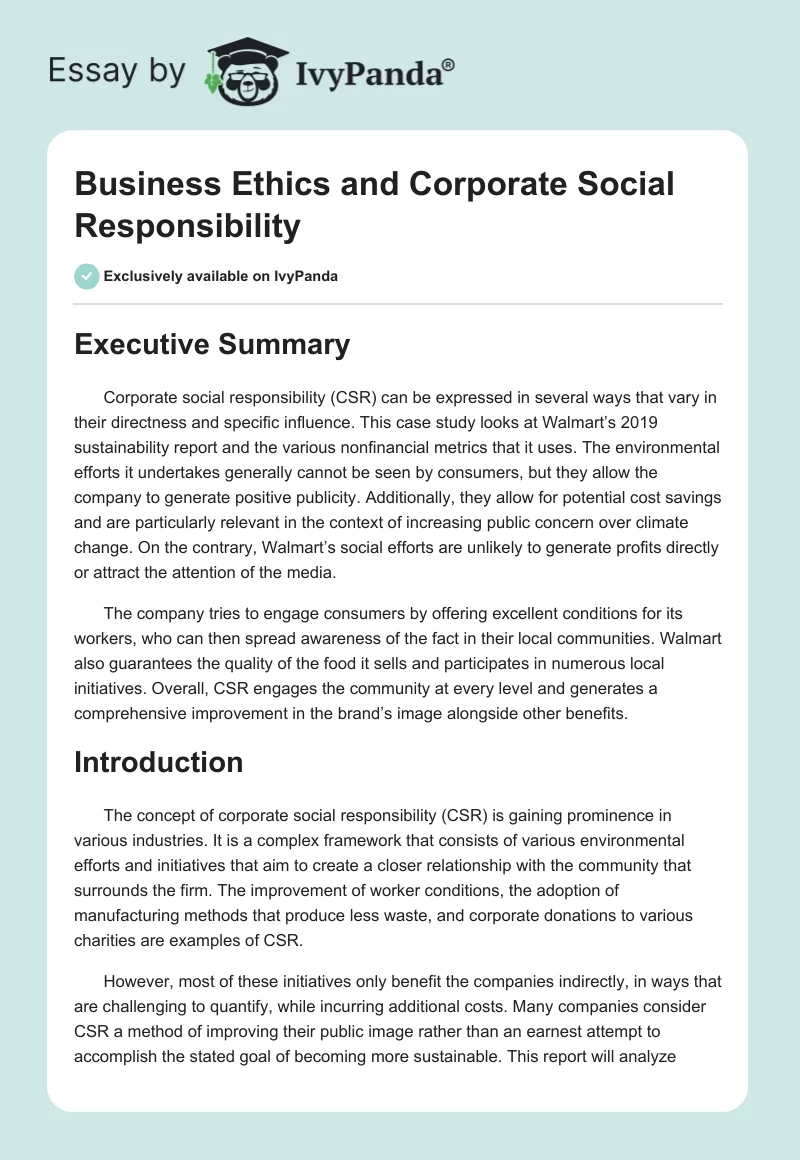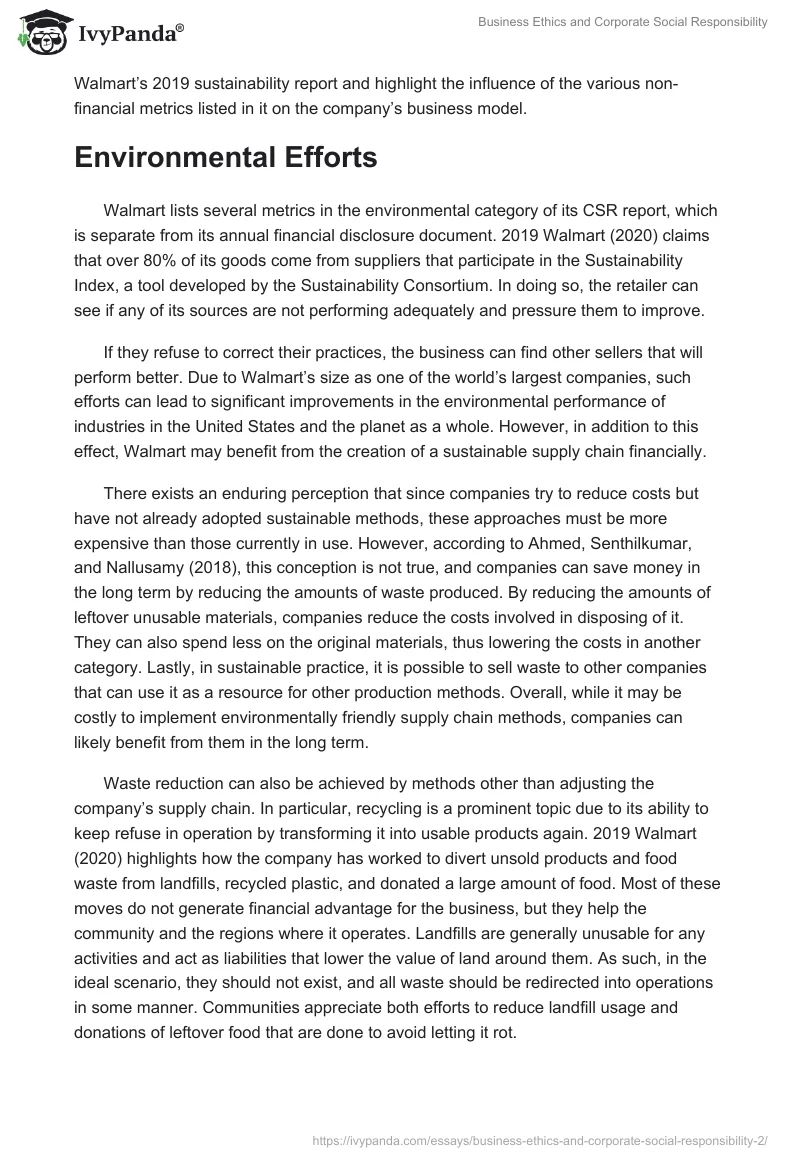Executive Summary
Corporate social responsibility (CSR) can be expressed in several ways that vary in their directness and specific influence. This case study looks at Walmart’s 2019 sustainability report and the various nonfinancial metrics that it uses. The environmental efforts it undertakes generally cannot be seen by consumers, but they allow the company to generate positive publicity. Additionally, they allow for potential cost savings and are particularly relevant in the context of increasing public concern over climate change. On the contrary, Walmart’s social efforts are unlikely to generate profits directly or attract the attention of the media.
The company tries to engage consumers by offering excellent conditions for its workers, who can then spread awareness of the fact in their local communities. Walmart also guarantees the quality of the food it sells and participates in numerous local initiatives. Overall, CSR engages the community at every level and generates a comprehensive improvement in the brand’s image alongside other benefits.
Introduction
The concept of corporate social responsibility (CSR) is gaining prominence in various industries. It is a complex framework that consists of various environmental efforts and initiatives that aim to create a closer relationship with the community that surrounds the firm. The improvement of worker conditions, the adoption of manufacturing methods that produce less waste, and corporate donations to various charities are examples of CSR.
However, most of these initiatives only benefit the companies indirectly, in ways that are challenging to quantify, while incurring additional costs. Many companies consider CSR a method of improving their public image rather than an earnest attempt to accomplish the stated goal of becoming more sustainable. This report will analyze Walmart’s 2019 sustainability report and highlight the influence of the various non-financial metrics listed in it on the company’s business model.
Environmental Efforts
Walmart lists several metrics in the environmental category of its CSR report, which is separate from its annual financial disclosure document. 2019 Walmart (2020) claims that over 80% of its goods come from suppliers that participate in the Sustainability Index, a tool developed by the Sustainability Consortium. In doing so, the retailer can see if any of its sources are not performing adequately and pressure them to improve.
If they refuse to correct their practices, the business can find other sellers that will perform better. Due to Walmart’s size as one of the world’s largest companies, such efforts can lead to significant improvements in the environmental performance of industries in the United States and the planet as a whole. However, in addition to this effect, Walmart may benefit from the creation of a sustainable supply chain financially.
There exists an enduring perception that since companies try to reduce costs but have not already adopted sustainable methods, these approaches must be more expensive than those currently in use. However, according to Ahmed, Senthilkumar, and Nallusamy (2018), this conception is not true, and companies can save money in the long term by reducing the amounts of waste produced. By reducing the amounts of leftover unusable materials, companies reduce the costs involved in disposing of it. They can also spend less on the original materials, thus lowering the costs in another category. Lastly, in sustainable practice, it is possible to sell waste to other companies that can use it as a resource for other production methods. Overall, while it may be costly to implement environmentally friendly supply chain methods, companies can likely benefit from them in the long term.
Waste reduction can also be achieved by methods other than adjusting the company’s supply chain. In particular, recycling is a prominent topic due to its ability to keep refuse in operation by transforming it into usable products again. 2019 Walmart (2020) highlights how the company has worked to divert unsold products and food waste from landfills, recycled plastic, and donated a large amount of food. Most of these moves do not generate financial advantage for the business, but they help the community and the regions where it operates. Landfills are generally unusable for any activities and act as liabilities that lower the value of land around them. As such, in the ideal scenario, they should not exist, and all waste should be redirected into operations in some manner. Communities appreciate both efforts to reduce landfill usage and donations of leftover food that are done to avoid letting it rot.
The last part of the company’s environmental aspect of CSR efforts consists of its effort to combat climate change. 2019 Walmart (2020) mentions a significant reduction in the company’s CO2 emissions as well as those of its supply chain.
The substance is considered a greenhouse gas and a significant contributor to climate change. Liu et al. (2016) claim that in addition to the direct reduction of global warming, emission savings could have additional effects on other aspects of the phenomenon. Overall, the changes can achieve savings for the company through a lower need to address environmental and health concerns. Moreover, as climate change is a popular topic, active efforts to address it from active pollution producers such as large companies can generate publicity and improve Walmart’s reputation. As such, efforts to help the environment can help the company both financially and in terms of public relations.
Social Initiatives
In addition to its environmentally-minded efforts, Walmart tries to position itself as an ethical company that treats both its employees and its customers with respect and attention. As with many retail businesses, it is affected by the perception that most of its jobs that do not require qualifications, such as cashier positions, do not pay adequate wages and offer no possibility of growth. 2019 Walmart (2020) attempts to combat this perception by claiming that the average wages of a full-time associate are $14.26 and that most management team members in the United States started in those entry-level positions.
Through this data, the company attempts to demonstrate that it is a place where people can work because they like the jobs rather than out of necessity. The message is that Walmart is a company where people go to succeed rather than a temporary position taken out of necessity.
As a company that sells large amounts of food products, Walmart is aware that negligence in its quality control measures can harm people and possibly cause deaths. 2019 Walmart (2020) highlights a variety of efforts it undertakes to ensure that its food is safe and the free health screenings it provides to people. The goal is both to assure people that the possibility of poisoning resulting from the consumption of its products is almost nonexistent and that the company will take responsibility if any issues occur. Consumer trust is critical to any business, and while marketing can contribute significantly to creating a positive reputation, people appreciate specific efforts to improve their experience. The knowledge that the foods one purchases have been extensively screened for safety improves one’s opinion of the brand from which one buys it.
However, such initiatives are usually too general for individual buyers to perceive any significant impact from their adoption. It is also an effective strategy to improve brand reputation on the local level by conducting specific efforts that are targeted at particular communities. 2019 Walmart (2020) mentions stakeholder meetings before the opening of new Walmart venues as well as local grants and volunteering by Walmart associates. The last aspect is not necessarily associated with the company, as the people choose to participate in the initiatives, but the company likely supports their efforts. Overall, the actions are aimed at humanizing Walmart’s image and establishing it as an entity that will listen to local concerns and try to help. People are likely to reciprocate such efforts and improve their opinions of the brand as a result.
Conclusion
As can be seen from Walmart’s sustainability report, companies undertake CSR efforts in a variety of ways. All of them improve the company’s image in some ways, usually at the expense of increased costs. However, the possibility of financial benefits exists with some of the environmental initiatives. Sustainable methods generate less waste and fewer health issues for which the company will be responsible. As such, it is possible to save costs on resources, garbage disposal, and medical treatment and time off. It can be challenging to quantify these benefits before the implementation, particularly because they have to compete with the cost of the transition. However, the examples of the companies that have adopted CSR practices show that the methods are worthwhile. Companies that want to be competitive should pay attention to the ethical, financial, and reputational advantages of CSR and implement its practices.
Reference List
2019 Walmart environmental, social & governance report (2020) Web.
Ahmed, A. K., Senthilkumar, C. B. and Nallusamy, S. (2018) ‘Study on environmental impact through analysis of big data for sustainable and green supply chain management’, International Journal of Mechanical and Production Engineering Research and Development, 8(1), pp. 1245-1254.
Liu, Z., Feng, K., Davis, S. J., Guan, D., Chen, B., Hubacek, K. and Yan, J. (2016) ‘Understanding the energy consumption and greenhouse gas emissions and the implication for achieving climate change mitigation targets’, Applied Energy, 184, pp. 737-741.


